Kaplan Business School - MBA501: Facebook Stakeholder Analysis Report
VerifiedAdded on 2022/10/10
|9
|2051
|238
Report
AI Summary
This report delivers a comprehensive stakeholder analysis of Facebook, examining the company's key stakeholders including users, employees, promoters, and owners. It begins with an executive summary and an overview of Facebook, encompassing its mission, recent developments, challenges, and industry trends. The report then presents a stakeholder view model, identifying specific stakeholders within each group. The core of the analysis focuses on four significant stakeholders: users, employees, promoters, and owners. Each stakeholder group is analyzed in terms of their behavior, motives, and potential coalitions, offering insights into their impact on Facebook's strategic vision and overall sustainability. The report concludes with a summary of the stakeholder analysis and a list of references.

MANAGEMENT
Running Head: MBA501 0
Running Head: MBA501 0
Paraphrase This Document
Need a fresh take? Get an instant paraphrase of this document with our AI Paraphraser
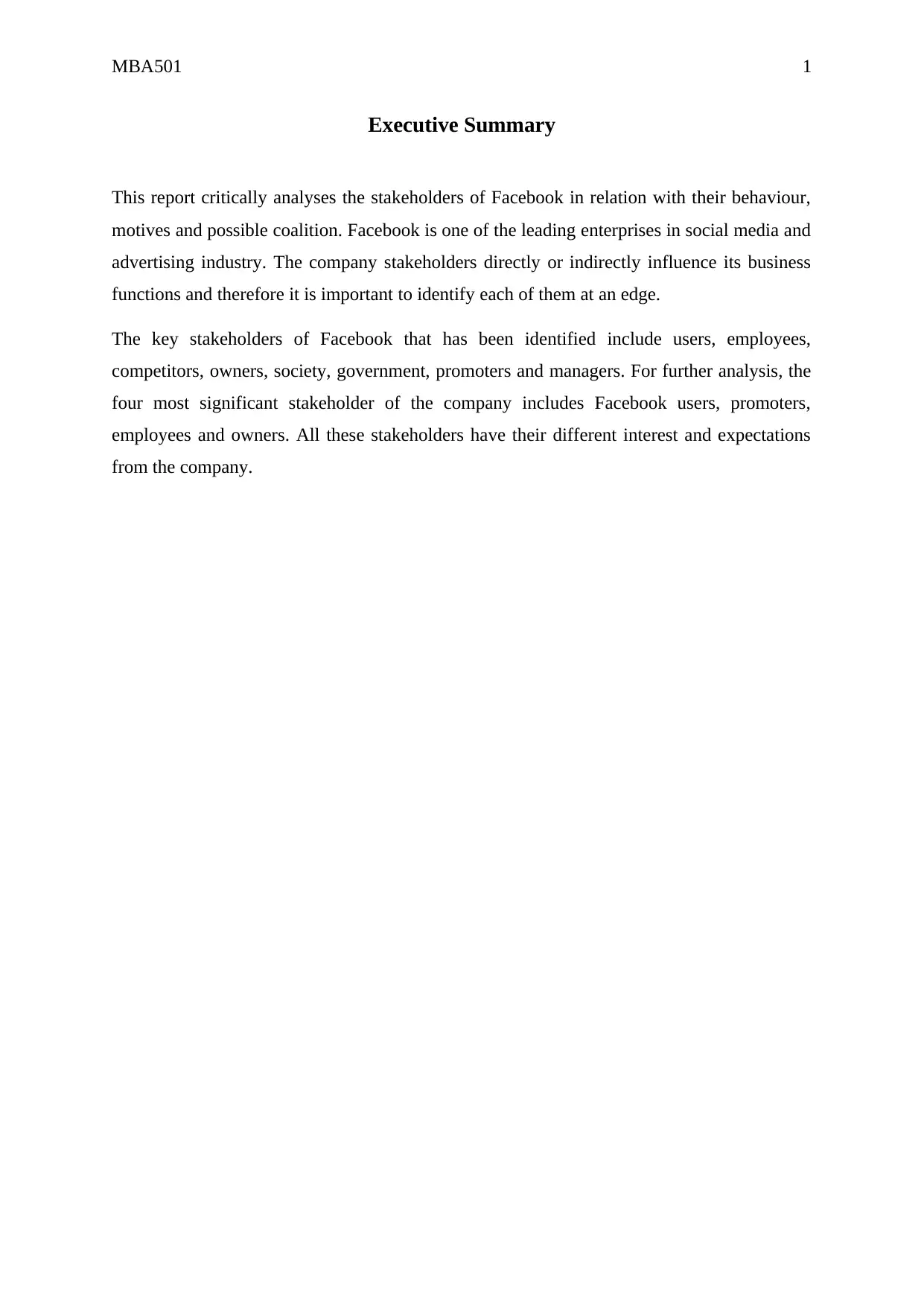
MBA501 1
Executive Summary
This report critically analyses the stakeholders of Facebook in relation with their behaviour,
motives and possible coalition. Facebook is one of the leading enterprises in social media and
advertising industry. The company stakeholders directly or indirectly influence its business
functions and therefore it is important to identify each of them at an edge.
The key stakeholders of Facebook that has been identified include users, employees,
competitors, owners, society, government, promoters and managers. For further analysis, the
four most significant stakeholder of the company includes Facebook users, promoters,
employees and owners. All these stakeholders have their different interest and expectations
from the company.
Executive Summary
This report critically analyses the stakeholders of Facebook in relation with their behaviour,
motives and possible coalition. Facebook is one of the leading enterprises in social media and
advertising industry. The company stakeholders directly or indirectly influence its business
functions and therefore it is important to identify each of them at an edge.
The key stakeholders of Facebook that has been identified include users, employees,
competitors, owners, society, government, promoters and managers. For further analysis, the
four most significant stakeholder of the company includes Facebook users, promoters,
employees and owners. All these stakeholders have their different interest and expectations
from the company.
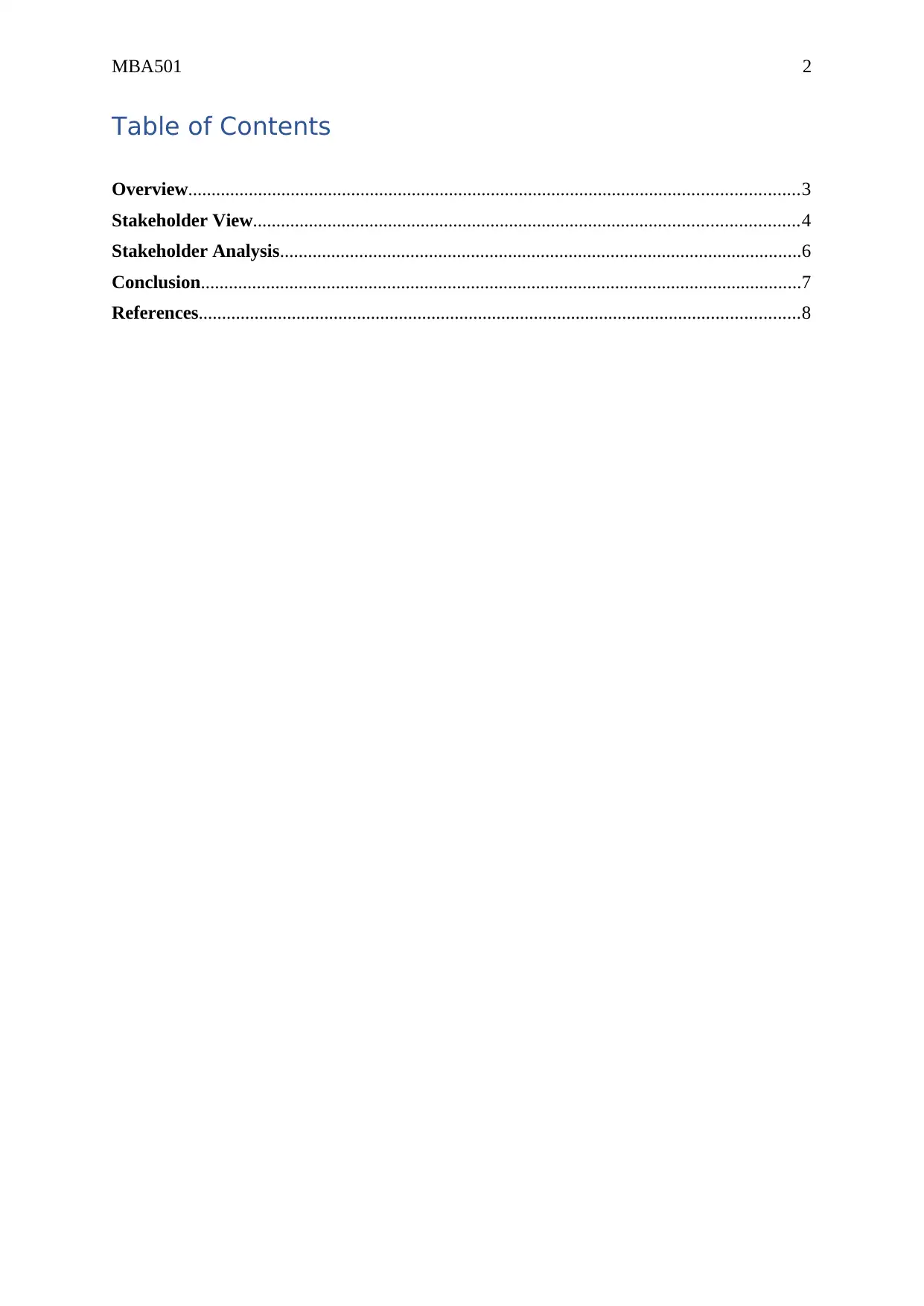
MBA501 2
Table of Contents
Overview...................................................................................................................................3
Stakeholder View.....................................................................................................................4
Stakeholder Analysis................................................................................................................6
Conclusion.................................................................................................................................7
References.................................................................................................................................8
Table of Contents
Overview...................................................................................................................................3
Stakeholder View.....................................................................................................................4
Stakeholder Analysis................................................................................................................6
Conclusion.................................................................................................................................7
References.................................................................................................................................8
⊘ This is a preview!⊘
Do you want full access?
Subscribe today to unlock all pages.

Trusted by 1+ million students worldwide
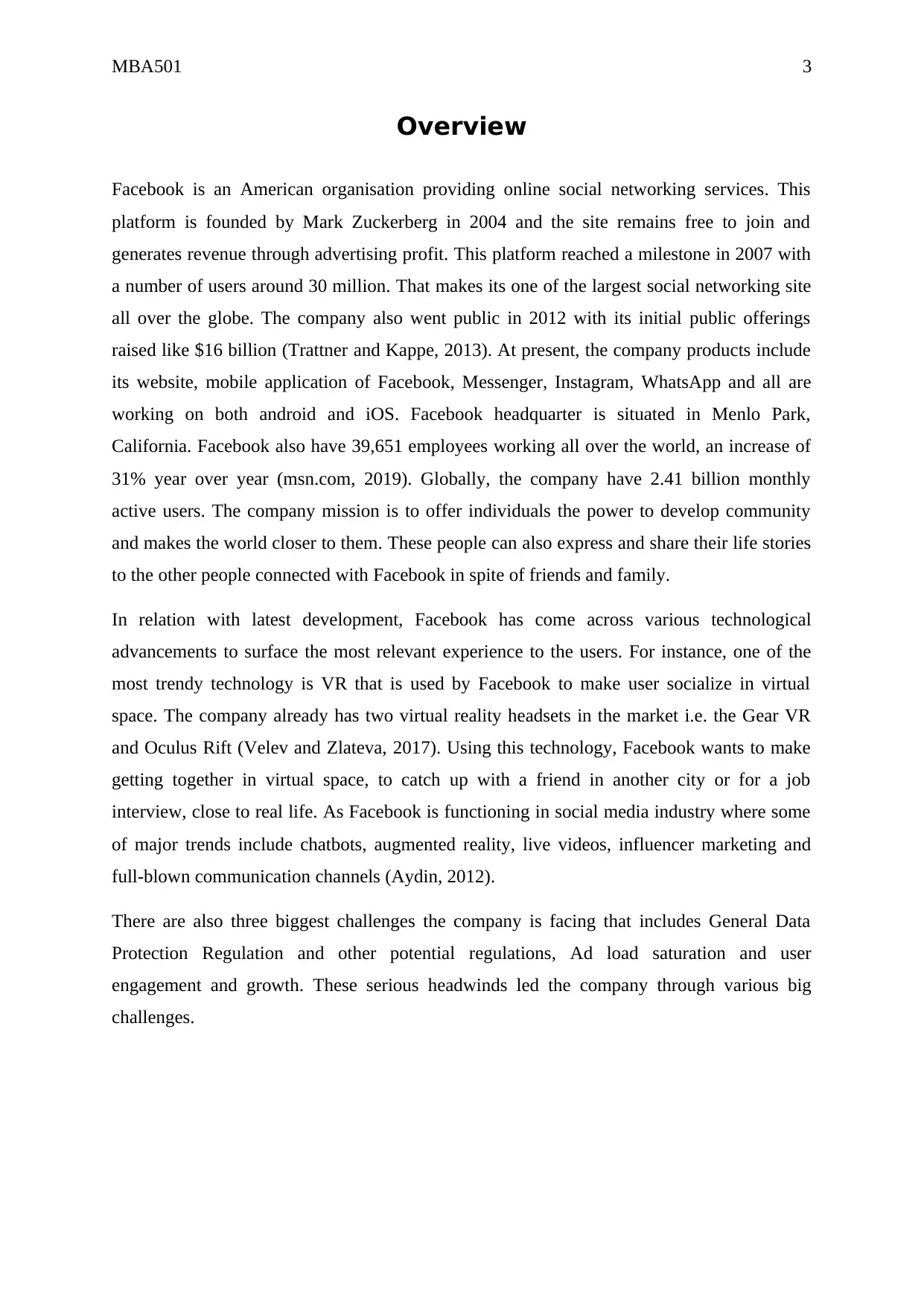
MBA501 3
Overview
Facebook is an American organisation providing online social networking services. This
platform is founded by Mark Zuckerberg in 2004 and the site remains free to join and
generates revenue through advertising profit. This platform reached a milestone in 2007 with
a number of users around 30 million. That makes its one of the largest social networking site
all over the globe. The company also went public in 2012 with its initial public offerings
raised like $16 billion (Trattner and Kappe, 2013). At present, the company products include
its website, mobile application of Facebook, Messenger, Instagram, WhatsApp and all are
working on both android and iOS. Facebook headquarter is situated in Menlo Park,
California. Facebook also have 39,651 employees working all over the world, an increase of
31% year over year (msn.com, 2019). Globally, the company have 2.41 billion monthly
active users. The company mission is to offer individuals the power to develop community
and makes the world closer to them. These people can also express and share their life stories
to the other people connected with Facebook in spite of friends and family.
In relation with latest development, Facebook has come across various technological
advancements to surface the most relevant experience to the users. For instance, one of the
most trendy technology is VR that is used by Facebook to make user socialize in virtual
space. The company already has two virtual reality headsets in the market i.e. the Gear VR
and Oculus Rift (Velev and Zlateva, 2017). Using this technology, Facebook wants to make
getting together in virtual space, to catch up with a friend in another city or for a job
interview, close to real life. As Facebook is functioning in social media industry where some
of major trends include chatbots, augmented reality, live videos, influencer marketing and
full-blown communication channels (Aydin, 2012).
There are also three biggest challenges the company is facing that includes General Data
Protection Regulation and other potential regulations, Ad load saturation and user
engagement and growth. These serious headwinds led the company through various big
challenges.
Overview
Facebook is an American organisation providing online social networking services. This
platform is founded by Mark Zuckerberg in 2004 and the site remains free to join and
generates revenue through advertising profit. This platform reached a milestone in 2007 with
a number of users around 30 million. That makes its one of the largest social networking site
all over the globe. The company also went public in 2012 with its initial public offerings
raised like $16 billion (Trattner and Kappe, 2013). At present, the company products include
its website, mobile application of Facebook, Messenger, Instagram, WhatsApp and all are
working on both android and iOS. Facebook headquarter is situated in Menlo Park,
California. Facebook also have 39,651 employees working all over the world, an increase of
31% year over year (msn.com, 2019). Globally, the company have 2.41 billion monthly
active users. The company mission is to offer individuals the power to develop community
and makes the world closer to them. These people can also express and share their life stories
to the other people connected with Facebook in spite of friends and family.
In relation with latest development, Facebook has come across various technological
advancements to surface the most relevant experience to the users. For instance, one of the
most trendy technology is VR that is used by Facebook to make user socialize in virtual
space. The company already has two virtual reality headsets in the market i.e. the Gear VR
and Oculus Rift (Velev and Zlateva, 2017). Using this technology, Facebook wants to make
getting together in virtual space, to catch up with a friend in another city or for a job
interview, close to real life. As Facebook is functioning in social media industry where some
of major trends include chatbots, augmented reality, live videos, influencer marketing and
full-blown communication channels (Aydin, 2012).
There are also three biggest challenges the company is facing that includes General Data
Protection Regulation and other potential regulations, Ad load saturation and user
engagement and growth. These serious headwinds led the company through various big
challenges.
Paraphrase This Document
Need a fresh take? Get an instant paraphrase of this document with our AI Paraphraser
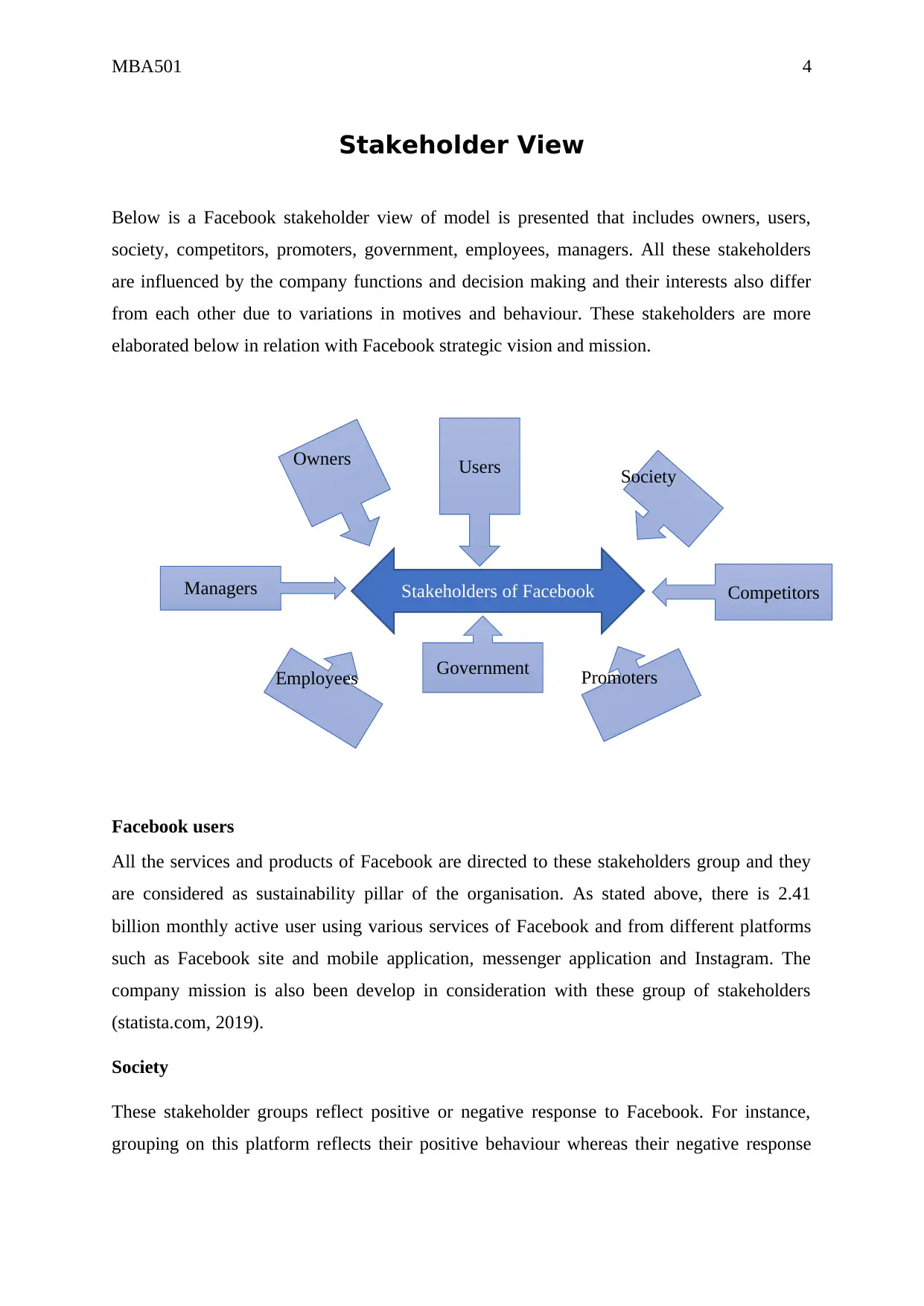
MBA501 4
Stakeholder View
Below is a Facebook stakeholder view of model is presented that includes owners, users,
society, competitors, promoters, government, employees, managers. All these stakeholders
are influenced by the company functions and decision making and their interests also differ
from each other due to variations in motives and behaviour. These stakeholders are more
elaborated below in relation with Facebook strategic vision and mission.
Facebook users
All the services and products of Facebook are directed to these stakeholders group and they
are considered as sustainability pillar of the organisation. As stated above, there is 2.41
billion monthly active user using various services of Facebook and from different platforms
such as Facebook site and mobile application, messenger application and Instagram. The
company mission is also been develop in consideration with these group of stakeholders
(statista.com, 2019).
Society
These stakeholder groups reflect positive or negative response to Facebook. For instance,
grouping on this platform reflects their positive behaviour whereas their negative response
Stakeholders of FacebookManagers
Users
Competitors
Government
Society
PromotersEmployees
Owners
Stakeholder View
Below is a Facebook stakeholder view of model is presented that includes owners, users,
society, competitors, promoters, government, employees, managers. All these stakeholders
are influenced by the company functions and decision making and their interests also differ
from each other due to variations in motives and behaviour. These stakeholders are more
elaborated below in relation with Facebook strategic vision and mission.
Facebook users
All the services and products of Facebook are directed to these stakeholders group and they
are considered as sustainability pillar of the organisation. As stated above, there is 2.41
billion monthly active user using various services of Facebook and from different platforms
such as Facebook site and mobile application, messenger application and Instagram. The
company mission is also been develop in consideration with these group of stakeholders
(statista.com, 2019).
Society
These stakeholder groups reflect positive or negative response to Facebook. For instance,
grouping on this platform reflects their positive behaviour whereas their negative response
Stakeholders of FacebookManagers
Users
Competitors
Government
Society
PromotersEmployees
Owners
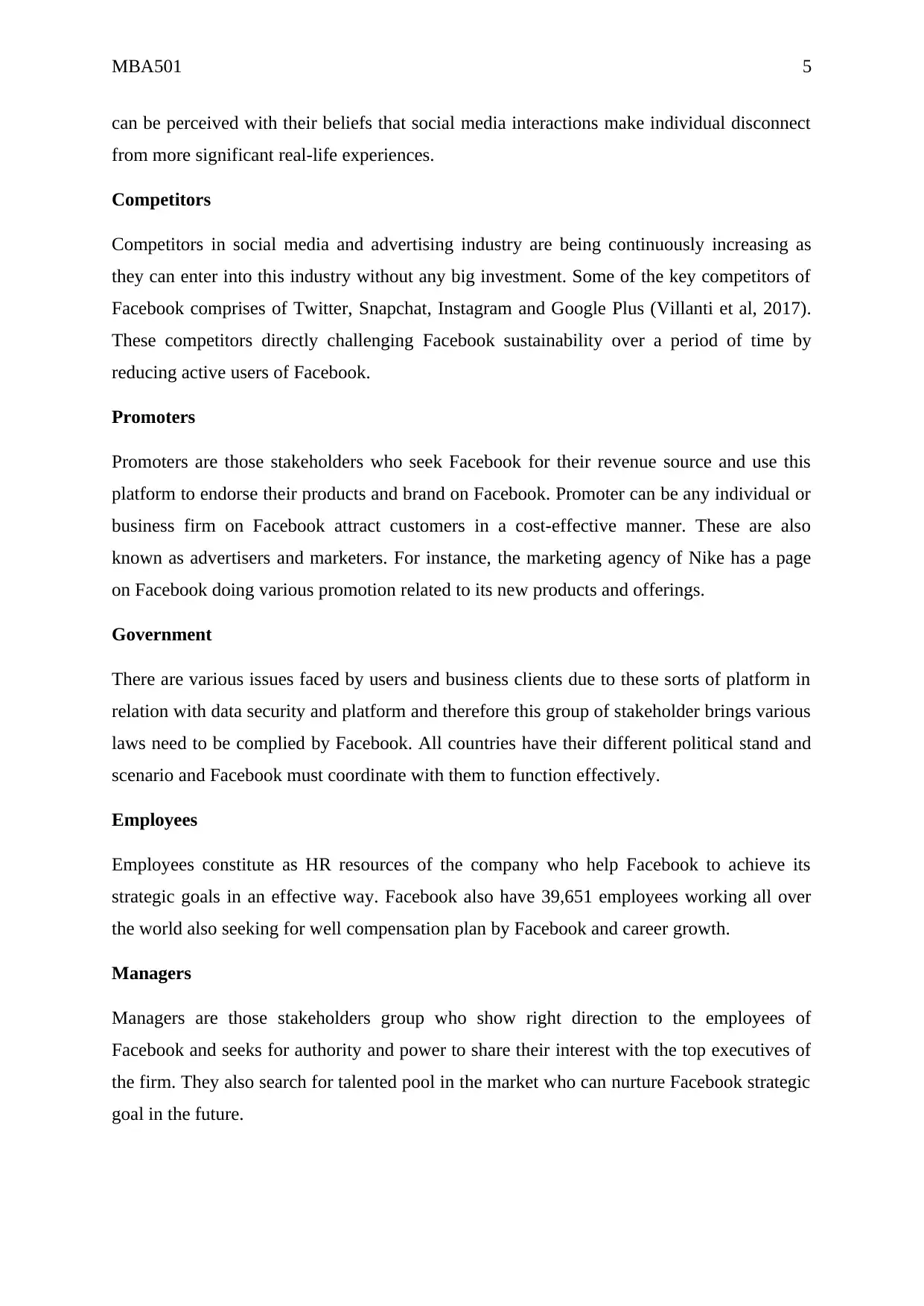
MBA501 5
can be perceived with their beliefs that social media interactions make individual disconnect
from more significant real-life experiences.
Competitors
Competitors in social media and advertising industry are being continuously increasing as
they can enter into this industry without any big investment. Some of the key competitors of
Facebook comprises of Twitter, Snapchat, Instagram and Google Plus (Villanti et al, 2017).
These competitors directly challenging Facebook sustainability over a period of time by
reducing active users of Facebook.
Promoters
Promoters are those stakeholders who seek Facebook for their revenue source and use this
platform to endorse their products and brand on Facebook. Promoter can be any individual or
business firm on Facebook attract customers in a cost-effective manner. These are also
known as advertisers and marketers. For instance, the marketing agency of Nike has a page
on Facebook doing various promotion related to its new products and offerings.
Government
There are various issues faced by users and business clients due to these sorts of platform in
relation with data security and platform and therefore this group of stakeholder brings various
laws need to be complied by Facebook. All countries have their different political stand and
scenario and Facebook must coordinate with them to function effectively.
Employees
Employees constitute as HR resources of the company who help Facebook to achieve its
strategic goals in an effective way. Facebook also have 39,651 employees working all over
the world also seeking for well compensation plan by Facebook and career growth.
Managers
Managers are those stakeholders group who show right direction to the employees of
Facebook and seeks for authority and power to share their interest with the top executives of
the firm. They also search for talented pool in the market who can nurture Facebook strategic
goal in the future.
can be perceived with their beliefs that social media interactions make individual disconnect
from more significant real-life experiences.
Competitors
Competitors in social media and advertising industry are being continuously increasing as
they can enter into this industry without any big investment. Some of the key competitors of
Facebook comprises of Twitter, Snapchat, Instagram and Google Plus (Villanti et al, 2017).
These competitors directly challenging Facebook sustainability over a period of time by
reducing active users of Facebook.
Promoters
Promoters are those stakeholders who seek Facebook for their revenue source and use this
platform to endorse their products and brand on Facebook. Promoter can be any individual or
business firm on Facebook attract customers in a cost-effective manner. These are also
known as advertisers and marketers. For instance, the marketing agency of Nike has a page
on Facebook doing various promotion related to its new products and offerings.
Government
There are various issues faced by users and business clients due to these sorts of platform in
relation with data security and platform and therefore this group of stakeholder brings various
laws need to be complied by Facebook. All countries have their different political stand and
scenario and Facebook must coordinate with them to function effectively.
Employees
Employees constitute as HR resources of the company who help Facebook to achieve its
strategic goals in an effective way. Facebook also have 39,651 employees working all over
the world also seeking for well compensation plan by Facebook and career growth.
Managers
Managers are those stakeholders group who show right direction to the employees of
Facebook and seeks for authority and power to share their interest with the top executives of
the firm. They also search for talented pool in the market who can nurture Facebook strategic
goal in the future.
⊘ This is a preview!⊘
Do you want full access?
Subscribe today to unlock all pages.

Trusted by 1+ million students worldwide
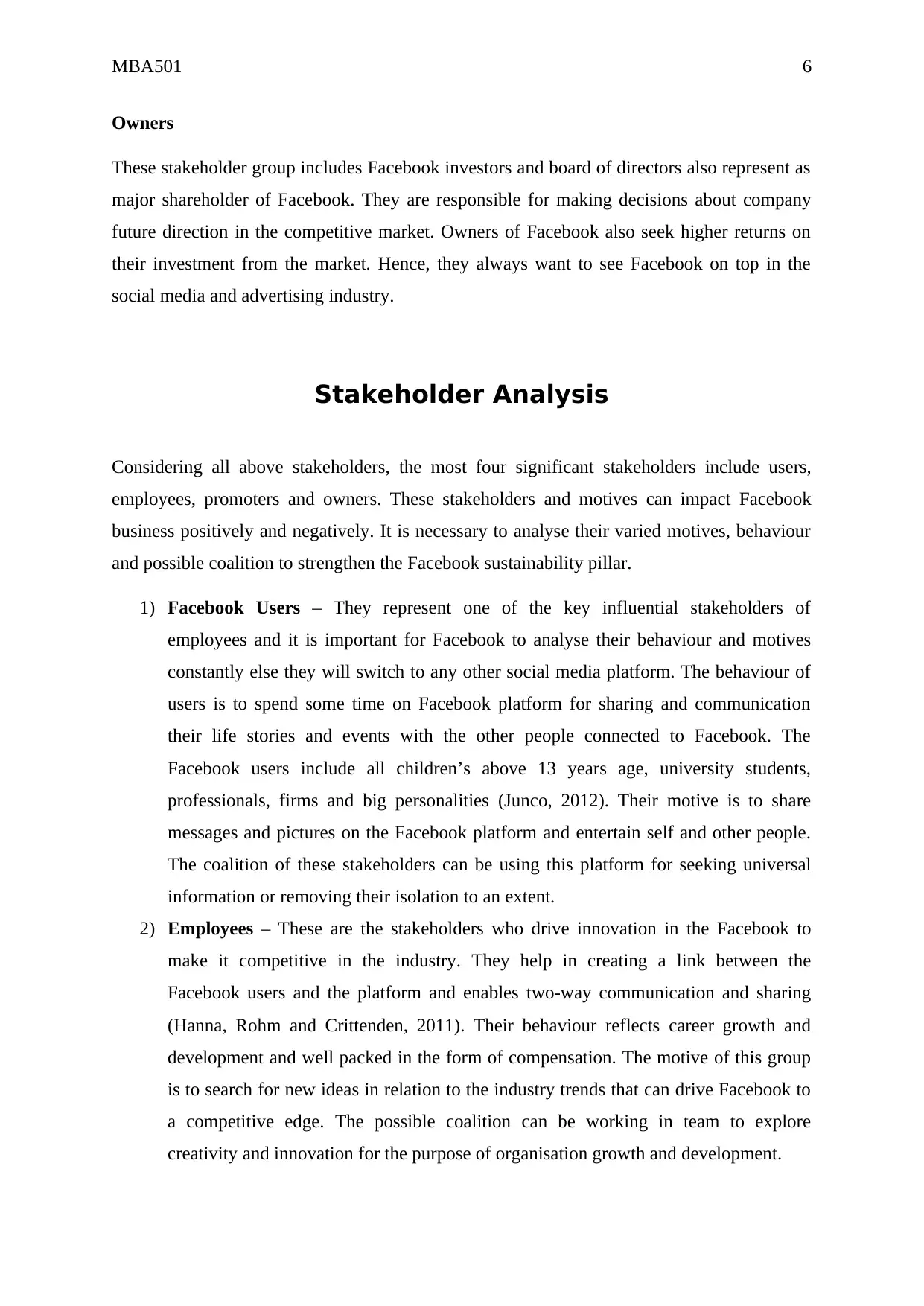
MBA501 6
Owners
These stakeholder group includes Facebook investors and board of directors also represent as
major shareholder of Facebook. They are responsible for making decisions about company
future direction in the competitive market. Owners of Facebook also seek higher returns on
their investment from the market. Hence, they always want to see Facebook on top in the
social media and advertising industry.
Stakeholder Analysis
Considering all above stakeholders, the most four significant stakeholders include users,
employees, promoters and owners. These stakeholders and motives can impact Facebook
business positively and negatively. It is necessary to analyse their varied motives, behaviour
and possible coalition to strengthen the Facebook sustainability pillar.
1) Facebook Users – They represent one of the key influential stakeholders of
employees and it is important for Facebook to analyse their behaviour and motives
constantly else they will switch to any other social media platform. The behaviour of
users is to spend some time on Facebook platform for sharing and communication
their life stories and events with the other people connected to Facebook. The
Facebook users include all children’s above 13 years age, university students,
professionals, firms and big personalities (Junco, 2012). Their motive is to share
messages and pictures on the Facebook platform and entertain self and other people.
The coalition of these stakeholders can be using this platform for seeking universal
information or removing their isolation to an extent.
2) Employees – These are the stakeholders who drive innovation in the Facebook to
make it competitive in the industry. They help in creating a link between the
Facebook users and the platform and enables two-way communication and sharing
(Hanna, Rohm and Crittenden, 2011). Their behaviour reflects career growth and
development and well packed in the form of compensation. The motive of this group
is to search for new ideas in relation to the industry trends that can drive Facebook to
a competitive edge. The possible coalition can be working in team to explore
creativity and innovation for the purpose of organisation growth and development.
Owners
These stakeholder group includes Facebook investors and board of directors also represent as
major shareholder of Facebook. They are responsible for making decisions about company
future direction in the competitive market. Owners of Facebook also seek higher returns on
their investment from the market. Hence, they always want to see Facebook on top in the
social media and advertising industry.
Stakeholder Analysis
Considering all above stakeholders, the most four significant stakeholders include users,
employees, promoters and owners. These stakeholders and motives can impact Facebook
business positively and negatively. It is necessary to analyse their varied motives, behaviour
and possible coalition to strengthen the Facebook sustainability pillar.
1) Facebook Users – They represent one of the key influential stakeholders of
employees and it is important for Facebook to analyse their behaviour and motives
constantly else they will switch to any other social media platform. The behaviour of
users is to spend some time on Facebook platform for sharing and communication
their life stories and events with the other people connected to Facebook. The
Facebook users include all children’s above 13 years age, university students,
professionals, firms and big personalities (Junco, 2012). Their motive is to share
messages and pictures on the Facebook platform and entertain self and other people.
The coalition of these stakeholders can be using this platform for seeking universal
information or removing their isolation to an extent.
2) Employees – These are the stakeholders who drive innovation in the Facebook to
make it competitive in the industry. They help in creating a link between the
Facebook users and the platform and enables two-way communication and sharing
(Hanna, Rohm and Crittenden, 2011). Their behaviour reflects career growth and
development and well packed in the form of compensation. The motive of this group
is to search for new ideas in relation to the industry trends that can drive Facebook to
a competitive edge. The possible coalition can be working in team to explore
creativity and innovation for the purpose of organisation growth and development.
Paraphrase This Document
Need a fresh take? Get an instant paraphrase of this document with our AI Paraphraser
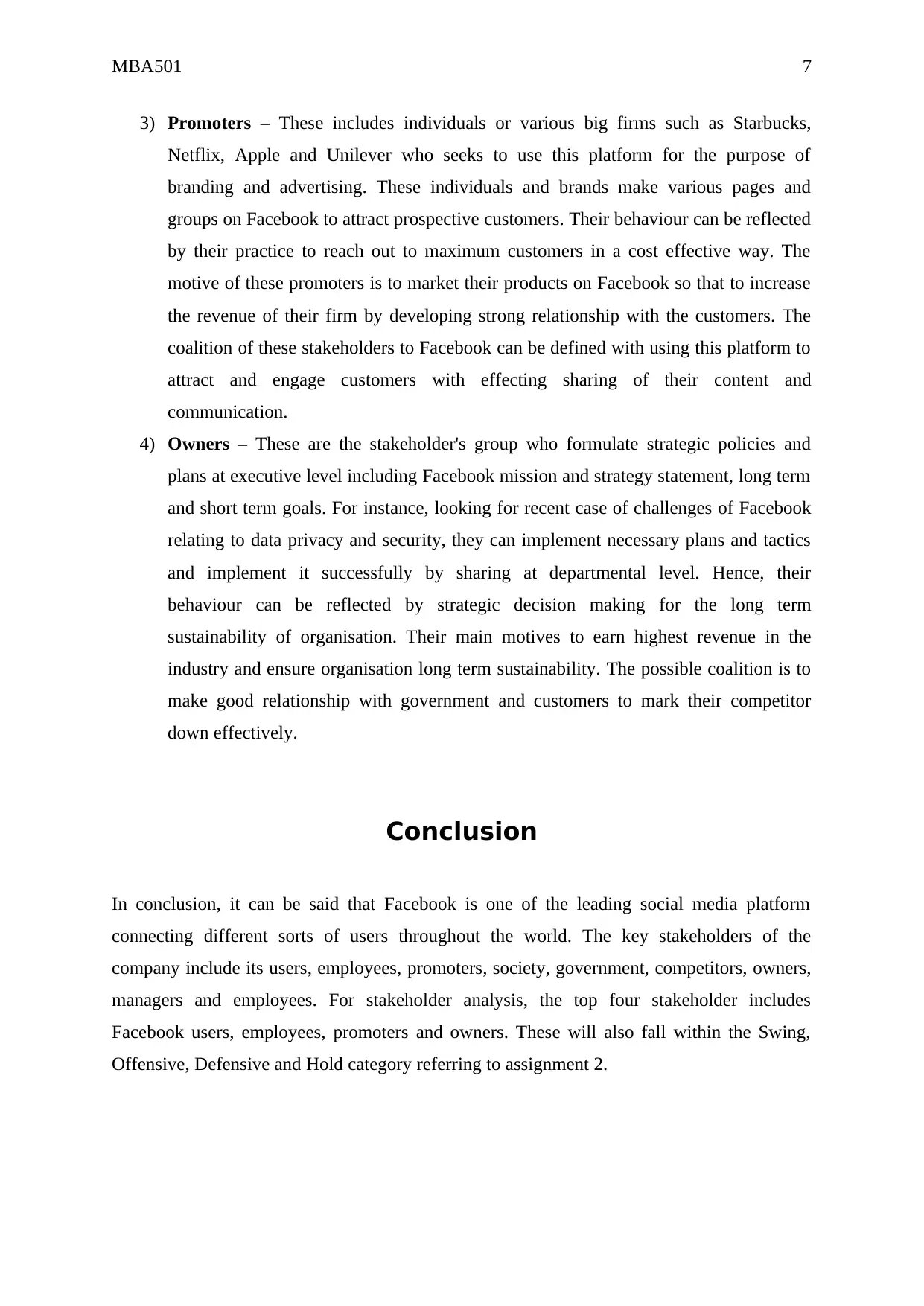
MBA501 7
3) Promoters – These includes individuals or various big firms such as Starbucks,
Netflix, Apple and Unilever who seeks to use this platform for the purpose of
branding and advertising. These individuals and brands make various pages and
groups on Facebook to attract prospective customers. Their behaviour can be reflected
by their practice to reach out to maximum customers in a cost effective way. The
motive of these promoters is to market their products on Facebook so that to increase
the revenue of their firm by developing strong relationship with the customers. The
coalition of these stakeholders to Facebook can be defined with using this platform to
attract and engage customers with effecting sharing of their content and
communication.
4) Owners – These are the stakeholder's group who formulate strategic policies and
plans at executive level including Facebook mission and strategy statement, long term
and short term goals. For instance, looking for recent case of challenges of Facebook
relating to data privacy and security, they can implement necessary plans and tactics
and implement it successfully by sharing at departmental level. Hence, their
behaviour can be reflected by strategic decision making for the long term
sustainability of organisation. Their main motives to earn highest revenue in the
industry and ensure organisation long term sustainability. The possible coalition is to
make good relationship with government and customers to mark their competitor
down effectively.
Conclusion
In conclusion, it can be said that Facebook is one of the leading social media platform
connecting different sorts of users throughout the world. The key stakeholders of the
company include its users, employees, promoters, society, government, competitors, owners,
managers and employees. For stakeholder analysis, the top four stakeholder includes
Facebook users, employees, promoters and owners. These will also fall within the Swing,
Offensive, Defensive and Hold category referring to assignment 2.
3) Promoters – These includes individuals or various big firms such as Starbucks,
Netflix, Apple and Unilever who seeks to use this platform for the purpose of
branding and advertising. These individuals and brands make various pages and
groups on Facebook to attract prospective customers. Their behaviour can be reflected
by their practice to reach out to maximum customers in a cost effective way. The
motive of these promoters is to market their products on Facebook so that to increase
the revenue of their firm by developing strong relationship with the customers. The
coalition of these stakeholders to Facebook can be defined with using this platform to
attract and engage customers with effecting sharing of their content and
communication.
4) Owners – These are the stakeholder's group who formulate strategic policies and
plans at executive level including Facebook mission and strategy statement, long term
and short term goals. For instance, looking for recent case of challenges of Facebook
relating to data privacy and security, they can implement necessary plans and tactics
and implement it successfully by sharing at departmental level. Hence, their
behaviour can be reflected by strategic decision making for the long term
sustainability of organisation. Their main motives to earn highest revenue in the
industry and ensure organisation long term sustainability. The possible coalition is to
make good relationship with government and customers to mark their competitor
down effectively.
Conclusion
In conclusion, it can be said that Facebook is one of the leading social media platform
connecting different sorts of users throughout the world. The key stakeholders of the
company include its users, employees, promoters, society, government, competitors, owners,
managers and employees. For stakeholder analysis, the top four stakeholder includes
Facebook users, employees, promoters and owners. These will also fall within the Swing,
Offensive, Defensive and Hold category referring to assignment 2.
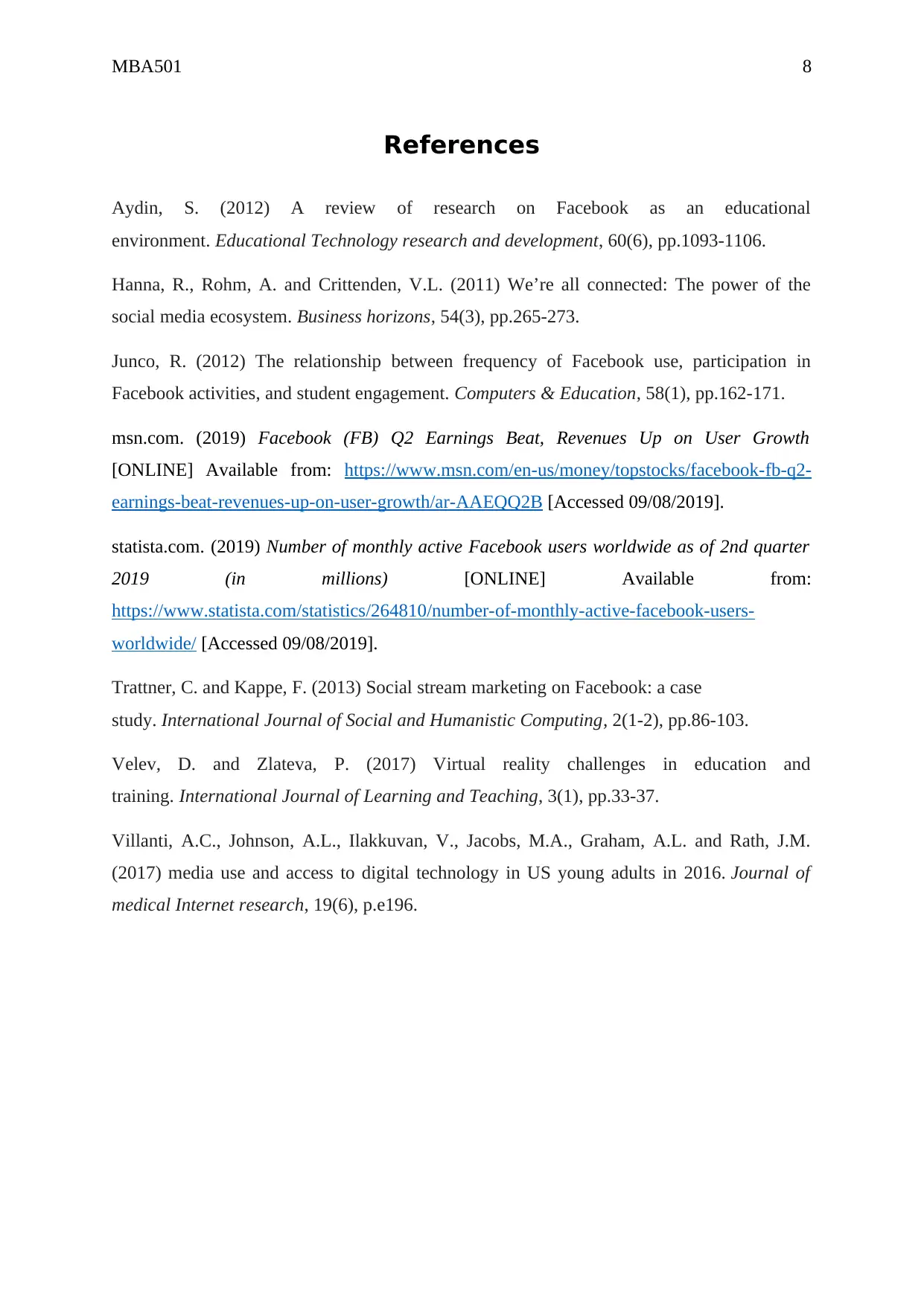
MBA501 8
References
Aydin, S. (2012) A review of research on Facebook as an educational
environment. Educational Technology research and development, 60(6), pp.1093-1106.
Hanna, R., Rohm, A. and Crittenden, V.L. (2011) We’re all connected: The power of the
social media ecosystem. Business horizons, 54(3), pp.265-273.
Junco, R. (2012) The relationship between frequency of Facebook use, participation in
Facebook activities, and student engagement. Computers & Education, 58(1), pp.162-171.
msn.com. (2019) Facebook (FB) Q2 Earnings Beat, Revenues Up on User Growth
[ONLINE] Available from: https://www.msn.com/en-us/money/topstocks/facebook-fb-q2-
earnings-beat-revenues-up-on-user-growth/ar-AAEQQ2B [Accessed 09/08/2019].
statista.com. (2019) Number of monthly active Facebook users worldwide as of 2nd quarter
2019 (in millions) [ONLINE] Available from:
https://www.statista.com/statistics/264810/number-of-monthly-active-facebook-users-
worldwide/ [Accessed 09/08/2019].
Trattner, C. and Kappe, F. (2013) Social stream marketing on Facebook: a case
study. International Journal of Social and Humanistic Computing, 2(1-2), pp.86-103.
Velev, D. and Zlateva, P. (2017) Virtual reality challenges in education and
training. International Journal of Learning and Teaching, 3(1), pp.33-37.
Villanti, A.C., Johnson, A.L., Ilakkuvan, V., Jacobs, M.A., Graham, A.L. and Rath, J.M.
(2017) media use and access to digital technology in US young adults in 2016. Journal of
medical Internet research, 19(6), p.e196.
References
Aydin, S. (2012) A review of research on Facebook as an educational
environment. Educational Technology research and development, 60(6), pp.1093-1106.
Hanna, R., Rohm, A. and Crittenden, V.L. (2011) We’re all connected: The power of the
social media ecosystem. Business horizons, 54(3), pp.265-273.
Junco, R. (2012) The relationship between frequency of Facebook use, participation in
Facebook activities, and student engagement. Computers & Education, 58(1), pp.162-171.
msn.com. (2019) Facebook (FB) Q2 Earnings Beat, Revenues Up on User Growth
[ONLINE] Available from: https://www.msn.com/en-us/money/topstocks/facebook-fb-q2-
earnings-beat-revenues-up-on-user-growth/ar-AAEQQ2B [Accessed 09/08/2019].
statista.com. (2019) Number of monthly active Facebook users worldwide as of 2nd quarter
2019 (in millions) [ONLINE] Available from:
https://www.statista.com/statistics/264810/number-of-monthly-active-facebook-users-
worldwide/ [Accessed 09/08/2019].
Trattner, C. and Kappe, F. (2013) Social stream marketing on Facebook: a case
study. International Journal of Social and Humanistic Computing, 2(1-2), pp.86-103.
Velev, D. and Zlateva, P. (2017) Virtual reality challenges in education and
training. International Journal of Learning and Teaching, 3(1), pp.33-37.
Villanti, A.C., Johnson, A.L., Ilakkuvan, V., Jacobs, M.A., Graham, A.L. and Rath, J.M.
(2017) media use and access to digital technology in US young adults in 2016. Journal of
medical Internet research, 19(6), p.e196.
⊘ This is a preview!⊘
Do you want full access?
Subscribe today to unlock all pages.

Trusted by 1+ million students worldwide
1 out of 9
Related Documents
Your All-in-One AI-Powered Toolkit for Academic Success.
+13062052269
info@desklib.com
Available 24*7 on WhatsApp / Email
![[object Object]](/_next/static/media/star-bottom.7253800d.svg)
Unlock your academic potential
Copyright © 2020–2025 A2Z Services. All Rights Reserved. Developed and managed by ZUCOL.





